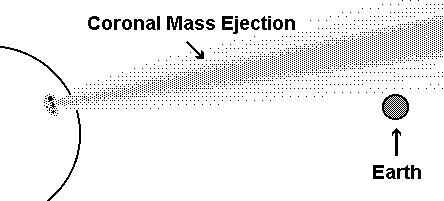The Sun-Aurora Connection
Jack Kramer
A few years ago during the peak of the current sunspot cycle, hardly a week went by without some sort of alert regarding solar activity. Now things are settling down. At higher latitudes, northern lights displays occur regularly, but around here, aurora displays usually seem to be no-shows or are a lot weaker than predicted. Well, once in awhile they show up as predicted. And as demonstrated by the activity this past November, auroras can occur at any time during the eleven-year solar cycle. Nonetheless, they still catch many of us by surprise. The LCAS member web site has some great full color images taken by our folks who checked the sky, then were quick with a camera.
Space is filled with debris from disintegrated comets, an ever-changing solar wind and radiation belts. The study of interactions between the Sun and Earth has led to a relatively new field of science known as "space weather". Practitioners attempt to predict and monitor solar flares, coronal mass ejections, geomagnetic storms and other space-related phenomena.
The most active type of solar flare is designated as the "X-class". This often produces a coronal mass ejection (CME) from the sun, which spews a large quantity of charged particles that have the potential for spawning an aurora within a day or so when the particles reach the Earth. These particles cause the gases in our atmosphere to glow, not unlike a fluorescent light bulb. Various solar observatories and organizations such as NOAA watch the position and trajectories of CMEs, but they are sometimes not able to forecast immediately whether we'll observe anything from this event. Some are directed too far to one side of the Earth to impact us due to the position of the flare on the face of the sun and the ejection pattern. There may still be a chance of an aurora if the CME passes near enough to dump some protons into the Earth's atmosphere. Also, if an area on the sun continues to be active for several days, then it might rotate into a position more directly in line with the Earth.

Data for solar alerts comes from observatories and from NASA spacecraft that monitor the interplanetary magnetic field. Observatories commonly use an instrument known as an emission line coronal photometer. Most alerts are concerned with the "Ca XV" emission, since this spectral line is associated with regions that have a high potential for energetic flares.
But these phenomena are not totally understood. Sometimes even a fast moving solar wind supposedly aimed in the right direction will result in weaker than expected geomagnetic disturbances. And to some extent, the data is subject to interpretation; various forecasters may place slightly different spins on the circumstances. For example, the following are two reports of the same event from different sources. The first one sounds a bit more optimistic.
"The solar wind velocity jumped from 420 to 520 km/s and the interplanetary magnetic field turned southward. These conditions are likely to create geomagnetic disturbances on Earth and possible displays of aurora borealis at middle latitudes."
"This disturbance is associated with moderately strong southwardly directed magnetic fields that is beginning to invigorate levels of geomagnetic and auroral activity. Although we do not expect this disturbance to amount to very much, there is the potential for periods of visible auroral activity over some upper-middle latitude regions over the next 6 to 12 hours."
A good way to keep abreast of the latest solar activity is to check out the Space Weather Internet site, which also has an abundance of solar-related links and allows you to subscribe to alert bulletins: http://www.spaceweather.com/
To see polar view images of Earth that suggest where an aurora is most likely, go to: http://solar.spacew.com/www/aurora.html
For those without Internet access, you may hear a recorded update on solar-terrestrial conditions by calling 303-497-3235.
Recently revised models have been able to better predict when solar storm particles will reach the Earth, but the extent of their effects are not really known until they actually arrive. Even if an aurora does occur, it may be confined to just one side of the Earth, rather than the entire circumference around the poles. So stay abreast of current activity ... better yet, keep your eyes to the sky.
Published in the December 2004 issue of the NightTimes




